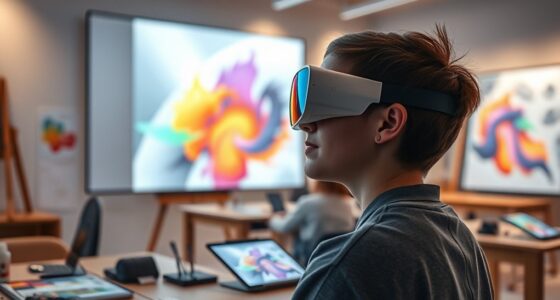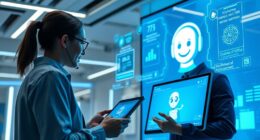Did you know that personalized learning has been shown to increase student engagement by up to 60%?
At our fingertips, we have the power to revolutionize education and empower students to take control of their own learning journey.
In this article, we will unveil expert strategies for mastering personalized learning.
From assessing individual needs to designing customized learning paths, we will explore practical ways to leverage technology and implement continuous feedback loops.

Get ready to unlock the true potential of personalized learning!
Key Takeaways
- Personalized learning benefits students by allowing them to learn at their own pace, focus on their strengths, and engage in relevant experiences.
- Teachers can tailor instruction, provide targeted support, and track progress effectively.
- Customized learning paths are designed based on individual goals and abilities.
- Technology allows for tailored instruction and targeted content.
Understanding Personalized Learning
In this article, we’ll explore the concept of personalized learning and its key components.
Personalized learning benefits both students and teachers in numerous ways. For students, it allows them to learn at their own pace, focus on their individual strengths, and engage in meaningful and relevant learning experiences. It also promotes self-directed learning and fosters a sense of ownership and responsibility for their education.
Teachers, on the other hand, can tailor instruction to meet the unique needs of each student, provide targeted support, and track progress more effectively.

However, implementing personalized learning comes with its own set of challenges. These include the need for adequate resources, training, and support for teachers, as well as addressing equity concerns and ensuring that all students have access to the necessary technology and tools.
Despite these challenges, personalized learning has the potential to revolutionize education and empower learners to reach their full potential.
Assessing Students’ Individual Needs
To accurately address students’ individual needs, we must assess their strengths, weaknesses, and learning preferences. Student assessment is a crucial step in providing effective personalized instruction. Here are three key strategies to consider:
-
Formative Assessment: Regularly assessing students’ progress and understanding throughout the learning process allows for immediate feedback and targeted interventions. This helps tailor instruction to meet individual needs.

-
Diagnostic Assessment: Conducting diagnostic assessments at the beginning of a learning unit helps identify students’ prior knowledge and any existing gaps. This information enables educators to design personalized learning experiences that build upon students’ existing strengths and address their weaknesses.
-
Multiple Measures: Using a variety of assessment methods, such as observations, portfolios, and performance tasks, provides a more comprehensive understanding of students’ abilities and preferences. This allows for a more accurate and holistic assessment of their individual needs.
Designing Customized Learning Paths
We create customized learning paths by carefully designing individualized routes for students to follow in order to achieve their learning goals. By incorporating adaptive assessments and differentiated instruction, we ensure that students receive personalized instruction tailored to their unique needs and abilities.
One effective strategy for designing customized learning paths is to use adaptive assessments. These assessments adapt to the student’s responses, providing immediate feedback and adjusting the difficulty level accordingly. This allows students to progress at their own pace, ensuring that they are neither bored nor overwhelmed.

Another crucial element in designing customized learning paths is differentiated instruction. This approach recognizes that students have different learning styles, preferences, and strengths. By providing a variety of instructional materials, activities, and assessments, we can cater to each student’s individual needs and interests, promoting engagement and deep understanding.
To illustrate the importance of designing customized learning paths, consider the following table:
| Student | Learning Goals | Path Design |
|---|---|---|
| Alex | Improve math skills | Integrate hands-on activities and real-world examples into math lessons |
| Emily | Enhance reading comprehension | Provide a variety of reading materials at different difficulty levels |
| Jake | Develop critical thinking skills | Incorporate problem-solving tasks and open-ended questions into lessons |
| Sophia | Strengthen writing skills | Offer individualized feedback and opportunities for revision |
Through adaptive assessments and differentiated instruction, we can create personalized learning paths that empower students to achieve their full potential.
Leveraging Technology for Personalization
By leveraging technology, we can further enhance the personalization of learning paths for students. Adaptive software allows us to tailor instruction to individual students’ needs, providing targeted content and activities that align with their specific learning goals. This technology analyzes students’ performance and progress in real-time, adjusting the difficulty and pace of lessons accordingly.

Differentiated instruction is another powerful tool that technology offers. With the help of digital platforms, teachers can provide a variety of resources and activities to cater to diverse learning styles and abilities. This allows students to engage with the content in ways that are most meaningful and effective for them.
Implementing Continuous Feedback Loops
As educators, our continuous feedback loops play a vital role in refining personalized learning experiences for our students. Implementing effective feedback loops is crucial for improving student engagement and enhancing teacher-student communication.
Research shows that providing timely and specific feedback helps students understand their strengths and areas for growth, ultimately motivating them to take ownership of their learning journey. By using a variety of feedback methods, such as verbal, written, and digital, we can cater to diverse learning preferences and ensure that students receive the support they need to succeed.
Engaging in regular conversations with students about their progress and goals also fosters a strong teacher-student relationship, creating a safe and trusting learning environment. By continuously refining our feedback practices, we empower our students to become active participants in their education and unlock their full potential.

Frequently Asked Questions
How Can Teachers Ensure That Personalized Learning Caters to the Unique Needs of Students With Learning Disabilities?
To ensure personalized learning caters to the unique needs of students with learning disabilities, we must prioritize individualized accommodations and inclusive practices. This approach fosters inclusivity, empowers students, and promotes a sense of belonging in the classroom.
What Are Some Effective Strategies for Managing Personalized Learning in Large Class Sizes?
When managing personalized learning in large class sizes, we prioritize effective classroom management and individualized instruction. By creating a supportive environment and utilizing technology, we can meet the unique needs of each student.
Are There Any Potential Drawbacks or Challenges Associated With Implementing Personalized Learning in Schools?
Implementing personalized learning in schools can present potential challenges and drawbacks. It requires significant planning, training, and support to ensure successful implementation. However, with proper guidance and resources, these challenges can be overcome, leading to improved student outcomes and engagement.
How Can Parents Be Involved in the Personalized Learning Process and Support Their Child’s Education at Home?
To support our child’s education at home, we can actively engage in their personalized learning journey. By fostering communication with teachers, establishing routines, and providing a conducive learning environment, we can ensure their success and growth.

What Role Does Social-Emotional Learning Play in Personalized Learning, and How Can It Be Effectively Integrated Into the Curriculum?
Social-emotional learning (SEL) plays a crucial role in personalized learning by promoting student well-being and enhancing their social skills. Integrating SEL into the curriculum can be challenging, but the benefits of supporting students’ emotional growth are worth it.
Conclusion
In conclusion, mastering personalized learning requires a deep understanding of students’ individual needs, designing customized learning paths, leveraging technology, and implementing continuous feedback loops.
One example of personalized learning success is the case of Sarah, a high school student who struggled with math. By using personalized learning techniques, Sarah was able to receive targeted instruction, practice at her own pace, and ultimately excel in the subject.
This real-life example showcases the power of personalized learning in transforming students’ educational journeys.












